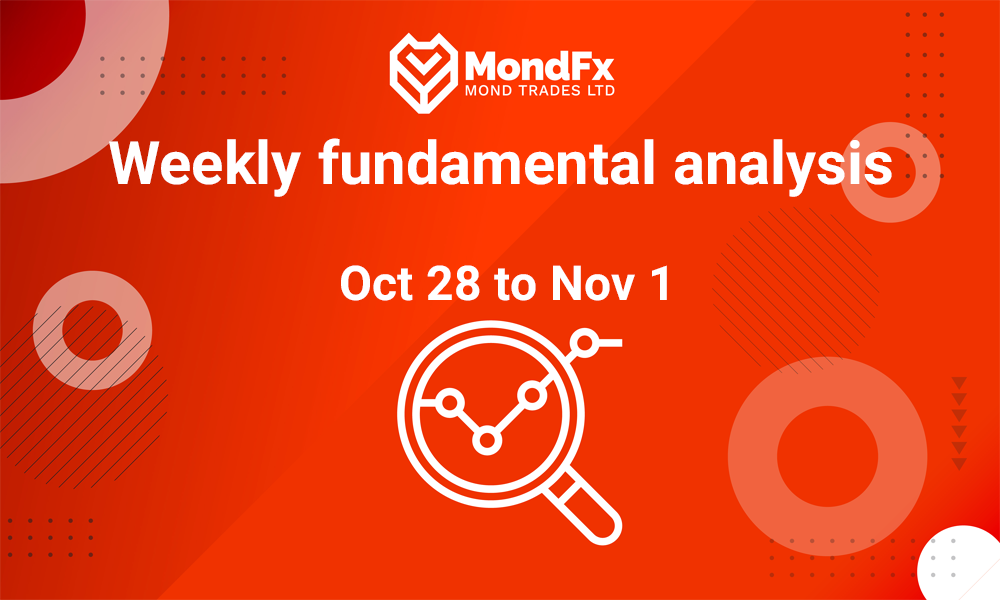
CCI Index
News release day: Tuesday, October 29
The CCI is published on the last Tuesday of each month and is widely regarded as the most reliable measure of consumer confidence in the United States. Essentially, the CCI measures the health of the U.S. economy based on consumers’ perceptions of current business conditions and employment, as well as their expectations for business, employment, and income over the next six months.
The Consumer Confidence Index plays a significant role in economic decision-making. An increase in this index indicates consumers’ confidence in the stability of incomes and their willingness to spend more, reflecting economic health. A decrease, on the other hand, could signal economic troubles and a decline in consumption and investment.
If consumer confidence rises excessively, people may spend more instead of saving, leading to higher demand that can trigger inflation. To prevent this, the Federal Reserve may raise interest rates to control economic growth through contractionary policies.
Following the implementation of contractionary policies in the United States, the value of the dollar increases. A rising dollar can reduce inflation by decreasing exports and increasing imports, as it leads to a greater supply of goods and services, helping to control prices and inflation.
Impact of the News: If the actual figure of this index is stronger than previous forecasts, it may have a positive impact on the demand for the U.S. dollar. In this case, currency pairs with the U.S. dollar as the base currency may rise, while cross-currency pairs and gold may decline.
A weak performance of this index compared to previous forecasts may negatively affect the growth of the U.S. dollar demand. In this scenario, the U.S. dollar and currency pairs where the dollar is the base currency may fall, while cross-currency pairs and gold may rise.

JOLTS Job Openings Index
News release day: Tuesday, October 29
The Job Openings Index is a survey conducted by the U.S. Bureau of Labor Statistics (BLS) within the Department of Labor to measure job vacancies. Through this index, which includes the collection, processing, and monthly publication of employment and labor turnover data, statistics on jobs where individuals are not currently active can be obtained. In other words, this index represents the number of job opportunities in a given month, excluding the agriculture sector.
Simply put, the Job Openings and Labor Turnover Survey (JOLTS) informs us about how many job openings exist each month, how many people were hired, how many left their jobs, how many were laid off, and how many separated from their jobs for other reasons (including worker deaths).
The JOLTS data can directly influence the decision-making of investors and forex traders by showing the state of labor demand and supply. An increase or decrease in job openings can be seen as an indicator of economic health and can lead to changes in exchange rates.
Impact of the News: If the actual figure of this index is stronger than previous forecasts, it may have a positive impact on the demand for the U.S. dollar. In this case, currency pairs with the U.S. dollar as the base currency may rise, while cross-currency pairs and gold may decline.
A weak performance of this index compared to previous forecasts may negatively affect the growth of the U.S. dollar demand. In this scenario, the U.S. dollar and currency pairs where the dollar is the base currency may fall, while cross-currency pairs and gold may rise.

Private Non-Farm Employment Change Index (ADP)
News release day: Wednesday, October 30
The ADP Index is a leading economic indicator that shows changes in employment numbers in the private sector of the U.S. economy. This index is calculated without considering agricultural, government, household, and nonprofit workers, and is based on payroll data from approximately 400,000 private companies in the U.S. that employ 23 million people.
The ADP Index is typically used to assess the state of the U.S. labor market and to predict the performance of the Non-Farm Payroll (NFP) index. However, the ADP index does not have a strong correlation with the NFP, meaning that strong growth in the ADP index does not necessarily indicate strong growth in the NFP. Generally, growth of fewer than 100,000 jobs per month in the ADP report is considered a warning sign for the U.S. economy.
The Federal Reserve takes the labor market into account when determining interest rates. Strong employment growth indicators suggest economic growth and can lead to an increase in interest rates and a strengthening of the dollar. Conversely, weak employment data can raise inflation concerns in financial markets, potentially leading to a decrease in interest rates and a weakening of the dollar.
Impact of the News: When the ADP Non-Farm Employment Change index exceeds expectations, the dollar tends to strengthen against other currencies, leading to a decline in gold prices and currencies against the dollar. Conversely, when the index falls below expectations, the dollar weakens against other currencies, resulting in an increase in gold prices and currencies against the dollar.
Non-Farm Employment Change Index
News release day: Friday, November 1
The ADP Non-Farm Employment Change is a monthly economic report that provides insights into the labor market. The ADP report forecasts the number of jobs created or lost in the private sector of the U.S. economy. It is often viewed as a precursor to the official Non-Farm Payroll report released a few days later by the Bureau of Labor Statistics (BLS).
This index is important for predicting the state of the labor market and economic growth in the U.S. An increase in private sector employment indicates economic growth and a strengthening dollar. However, if employment figures rise or fall sharply, it could lead to increased inflation and concerns in financial markets. This report can assist the Federal Reserve (Fed) in determining its policies regarding interest rate increases or decreases.
Impact of the News: When the Non-Farm Employment Change index exceeds expectations, the dollar tends to strengthen against other currencies, leading to a decline in gold prices and currencies against the dollar. Conversely, when the index falls below expectations, the dollar weakens against other currencies, resulting in an increase in gold prices and currencies against the dollar.

GDP Index
News release day: Wednesday, October 30
The Gross Domestic Product (GDP) index is a lagging indicator that represents the market value (monetary value) of all final goods and services produced within a country’s borders during a specific time period (monthly, quarterly, or annually).
This index is usually published quarterly and compared to the previous period (on an annual basis), with data reflecting the value of one quarter compared to the same quarter of the previous year. GDP can be considered the largest indicator of a country’s economic health, as it reflects the rate of economic growth.
As GDP increases, we typically see a rise in per capita income for individuals in society, which in turn boosts consumer spending and improves conditions for producers across various sectors of the economy, including housing, industrial factories, agriculture, and services. Growth in the GDP index is a positive factor for national economic development, and consequently, an increase in GDP can lead to a rise in the value of the dollar. As a result, fluctuations in the forex market are observed during GDP releases.
Paying attention to the monthly and annual percentages of GDP and their changes can create attractive opportunities for all investors, including forex traders.
Impact of the News: If the actual figure of this index is stronger than previous forecasts, it may have a positive impact on the demand for the U.S. dollar. In this case, currency pairs with the U.S. dollar as the base currency may rise, while cross-currency pairs and gold may decline.
A weak performance of this index compared to previous forecasts may negatively affect the growth of the U.S. dollar demand. In this scenario, the U.S. dollar and currency pairs where the dollar is the base currency may fall, while cross-currency pairs and gold may rise.

PCE Index
News release day: Thursday, October 31
One of the most important and influential economic indicators for measuring inflation in the United States is the PCE price index, which tracks changes in the prices of goods and services purchased by consumers and non-governmental organizations, excluding food and energy costs. These changes are expressed as a percentage.
In 2012, the Personal Consumption Expenditures (PCE) index became the Federal Reserve’s primary inflation gauge. It is compared to the Consumer Price Index (CPI), which focuses primarily on consumer prices. Consequently, changes in the PCE index significantly impact the Federal Reserve’s decisions, especially regarding policy rates or interest rates.
The PCE index effectively measures inflation in the United States, consistently tracking price changes for goods and services purchased by consumers. It indicates how much prices have increased (in the case of positive inflation) or decreased (in the case of negative inflation).
Overall, the PCE price index and the core PCE price index (excluding food and energy) reflect the changes in personal consumption prices from one period to another.
Impact of the News: When the PCE index exceeds expectations, the dollar tends to strengthen against other currencies, leading to a decline in gold prices and currencies against the dollar. Conversely, when the index falls below expectations, the dollar weakens against other currencies, resulting in an increase in gold prices and currencies against the dollar.

Employment Cost Index q/q
News release day:Thursday, October 31
The Employment Cost Index (ECI) is a report from the U.S. Department of Labor used to measure the growth of employee wages in a given quarter compared to the previous quarter. The ECI measures changes in the prices that businesses and the government pay for civilian labor. This index is calculated based on surveys of employers conducted in the final month of each quarter and takes into account a wide range of benefits and additional compensation such as annual leave, sick leave, insurance payments, pensions, and more.
Economists use this index to measure changes in labor costs and assess the health of the economy. The ECI can significantly move markets if it shows notable differences from street estimates. Increases in compensation costs are typically passed on to consumers because the costs for companies are substantial.
Impact of the News: When the ECI is higher than expectations, the dollar tends to strengthen against other currencies, leading to a decline in gold prices and currencies against the dollar. Conversely, when the index is lower than expectations, the dollar weakens against other currencies, resulting in an increase in gold prices and currencies against the dollar.

Unemployment Claims Index
Thursday, October 31
The unemployment claims report is a key economic indicator for identifying unemployment trends. As a lagging economic indicator, it monitors past labor market performance and measures the number of unemployed individuals by subtracting those who have found jobs and adding those who have recently begun seeking work.
By comparing the current period’s rate with the previous period, it can be determined how many people are seeking government support, allowing us to infer whether unemployment is trending upward or downward.
An upward trend in the unemployment rate may lead the central bank to consider lowering interest rates to stimulate a weakening economy. Conversely, if unemployment is decreasing, the central bank may raise interest rates to control inflation and strengthen the currency. When unemployment rates are reported to be very high, or if there is an unexpectedly large increase, governments do not favor this outcome. In such cases, the central bank may lower interest rates to help stimulate the economy, and the government may also implement fiscal policies to encourage job growth.
Unemployment rate reports are often accompanied by significant volatility in currency markets. Expectations for interest rates in the hours following the report create several high-risk, high-return opportunities.
Impact of the News: When unemployment claims are lower than expected, the dollar tends to strengthen against other currencies, leading to a decline in gold prices and currencies against the dollar. Conversely, when the index is higher than expected, the dollar weakens against other currencies, resulting in an increase in gold prices and currencies against the dollar.

Average Hourly Earnings m/m
News release day: : Friday, November 1
The Average Hourly Earnings index reflects monthly changes in average hourly earnings across most non-agricultural industries for a specified month compared to the previous month. This index only includes employees of private companies.
In the United States, wages are calculated and paid using the Average Hourly Earnings metric. The data for this index pertains to production employees in mining, construction workers, and non-supervisory staff in the service-providing industries. These groups account for nearly four-fifths of total Non-Farm Payroll (NFP) figures.
The Average Hourly Earnings index is a leading indicator for consumer inflation. When businesses pay more for labor, these increased costs are typically passed on to the end consumer.
Impact of the News: When the Average Hourly Earnings index is higher than expected, the dollar tends to strengthen against other currencies, leading to a decline in gold prices and currencies against the dollar. Conversely, when the index is lower than expected, the dollar weakens against other currencies, resulting in an increase in gold prices and currencies against the dollar.

Unemployment Rate Index
News release day: Friday, November 1
The Unemployment Rate indicates the proportion of unemployed individuals to the total number of people who can work. It is considered a key economic indicator for identifying unemployment trends. By comparing the current rate with the previous period, one can determine whether unemployment is trending upward or downward. Changes in the unemployment rate are correlated with business confidence in the national economy.
This index is one of the most important economic indicators in Forex, as an increase in the unemployment rate generally leads to a decrease in the value of the national currency, making it essential to monitor closely.
A low unemployment rate is a positive sign. Therefore, if the unemployment rate is low, the corresponding currency will strengthen. A low unemployment rate often leads to the implementation of contractionary policies or increases in interest rates. Conversely, a high unemployment rate is a negative signal for the economy and will adversely affect the dollar, as the central bank will likely attempt to ease monetary policies to combat unemployment. In the United States, the unemployment rate is reported monthly based on accurate surveys, with an annual rate determined at the end of the year.
Impact of the News: A significant decrease in the unemployment rate compared to the previous period will strengthen the value of the dollar. If the reported figure is lower than expectations, it positively impacts the U.S. dollar and currency pairs where the dollar is the base currency, while cross currencies and gold will decrease, and vice versa.

Manufacturing PMI Index
News release day: Friday, November 1
The ISM Manufacturing Index, also known as the Purchasing Managers’ Index (PMI), is a monthly indicator of economic activity in the United States. It is based on a survey of approximately 300 purchasing managers, who are asked to assess the relative level of business conditions in areas such as employment, production, new orders, prices, supplier deliveries, and inventories. The ISM Manufacturing Report is released on the first business day of each month.
The ISM PMI is recognized as a leading indicator of economic health, as businesses quickly respond to market conditions, and their purchasing managers may have the most current insights into the economic situation.
This index provides a numerical value indicating whether the manufacturing sector is expanding or contracting. If the PMI is above 50, it indicates that the manufacturing sector has grown compared to the previous month. If it is equal to 50, it signifies no change, and if it is below 50, it indicates that the manufacturing sector has contracted compared to the previous month.
Impact of the News: If the ISM PMI is better than the previous month and above the expected figure, the U.S. dollar is likely to strengthen, leading to a decline in cross currencies and gold prices, and vice versa.

